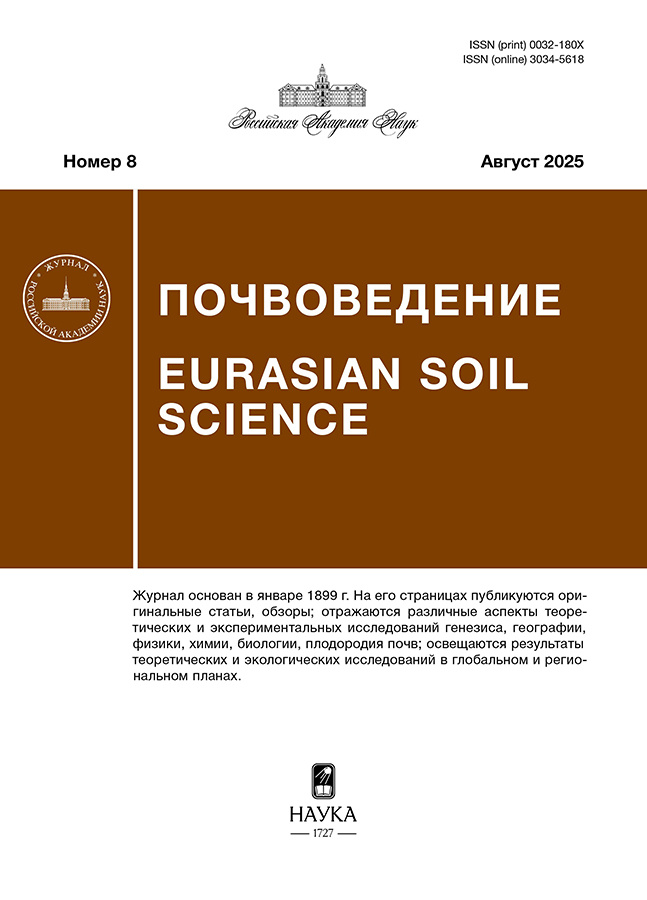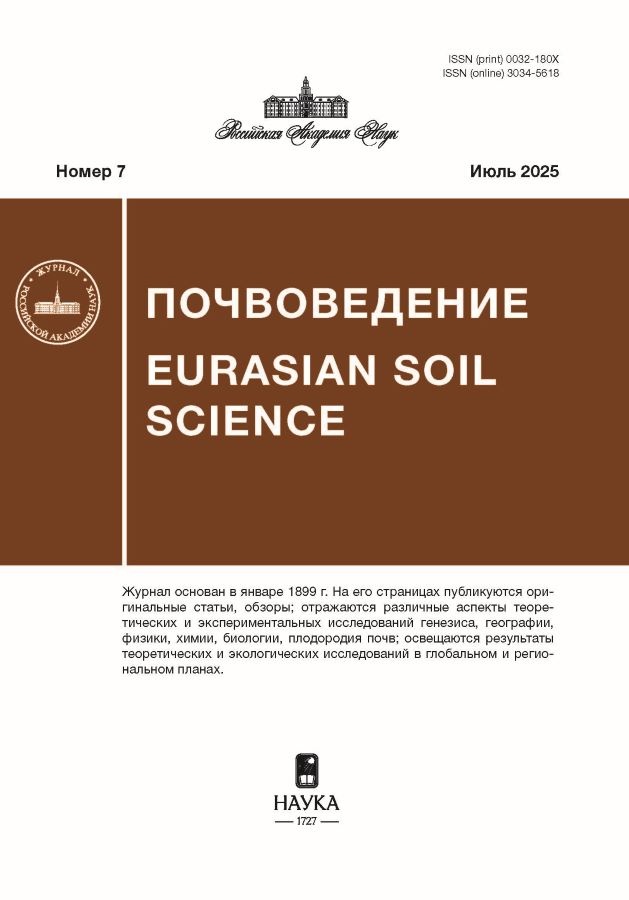Особенности первичного почвообразования в условиях южной тундры европейского северо-востока России
- Авторы: Лиханова И.А.1, Денева С.В.1, Лаптева Е.М.1
-
Учреждения:
- Институт биологии Коми научного центра Уральского отделения РАН
- Выпуск: № 7 (2025)
- Страницы: 898-912
- Раздел: ГЕНЕЗИС И ГЕОГРАФИЯ ПОЧВ
- URL: https://www.clinpractice.ru/0032-180X/article/view/687381
- DOI: https://doi.org/10.31857/S0032180X25070023
- EDN: https://elibrary.ru/HTHDEN
- ID: 687381
Цитировать
Полный текст
Аннотация
Рассмотрено влияние гидроморфизма и гранулометрического состава субстрата (суглинки, пески, гравийно-песчаные отложения) на процессы начального педогенеза в условиях южной кустарниковой тундры европейского северо-востока России. Проанализированы морфологическое строение профилей, физические и физико-химические свойства и химический состав зрелых и молодых почв. Показано, что в 4(5)–6 десятилетиях самовосстановительной сукцессии на территории карьеров по добыче полезных ископаемых (строительного песка) процессы почвообразования и развития растительного покрова взаимосвязаны и определяются свойствами почвообразующих пород. В дренированных условиях в песчаных, гравийно-песчаных и суглинистых почвах карьеров отмечены: обособление органогенных горизонтов (подстилок), снижение плотности почв в верхней минеральной части профиля, тенденция к перераспределению в профиле илистой фракции, соединений Fe и Al. В суглинистых почвах слабо выражены признаки оглеения в верхней части профиля, гравийно-песчаных – аккумуляции соединений Al и Fe в подподстилочном слое, песчаных – подзолообразования. Для переувлажненных почв характерно развитие процессов оторфовывания, потечности гумуса и оглеения. Процессы начального педогенеза в биоклиматических условиях тундры замедлены. Об этом свидетельствуют: (1) слабое проявление зональных признаков почвообразования в профилях молодых почв; (2) низкая скорость накопления органического углерода в профиле почв. На песчаных и гравийно-супесчаных отложениях скорость накопления углерода в слое 0–20 см почв, формирующихся в автоморфных условиях, составляет менее 0.1 т/(га год), в полугидроморфных – 0.25–0.30 т/(га год), в гидроморфных – 0.42 т/(га год). На суглинистых отложениях этот параметр достигает соответственно 0.28, 0.31 и 0.61 т/(га год).
Полный текст
Об авторах
И. А. Лиханова
Институт биологии Коми научного центра Уральского отделения РАН
Автор, ответственный за переписку.
Email: likhanova@ib.komisc.ru
ORCID iD: 0000-0001-8781-4768
Россия, Сыктывкар
С. В. Денева
Институт биологии Коми научного центра Уральского отделения РАН
Email: likhanova@ib.komisc.ru
Россия, Сыктывкар
Е. М. Лаптева
Институт биологии Коми научного центра Уральского отделения РАН
Email: likhanova@ib.komisc.ru
Россия, Сыктывкар
Список литературы
- Абакумов Е.В., Гагарина Э.И. Почвообразование в посттехногенных экосистемах карьеров на северо-западе Русской равнины. СПб.: Изд-во СПбГУ, 2006. 208 с.
- Аксенова Ю.В., Гиндемит А.М. Влияние рельефа на показатели плодородия почв // Земледелие. 2024. № 2. С. 19–24. https://doi.org/10.24412/0044-3913-2024-2-19-24.
- Арчегова И.Б., Цыпанова А.Н. К вопросу о миграции железа и органического вещества в почвах Восточно-европейской тундры (Воркута) // Химия, генезис и картография почв. М.: Наука, 1968. С. 32–36.
- Атлас почв Республики Коми. Сыктывкар: Коми республиканская типография, 2010. 356 c.
- Водяницкий Ю.Н. Диагностика переувлажненных минеральных почв. М.: Почв. институт им. В.В. Докучаева, 2008. 83 с.
- Восстановление земель на Крайнем Севере. Сыктывкар: Коми НЦ УрО РАН, 2000. 152 с.
- Данилов И.Д. Водораздельные песчано-галечные отложения Воркутского района // Кайнозойский покров Большеземельской тундры. Изд-во МГУ. 1963. С. 192–210.
- Евдокимова Г.А., Мозгова Н.П. Микроорганизмы тундровых и лесных подзолов Кольского Севера. Апатиты: Кольский НЦ РАН, 2001. 184 с.
- Забоева И.В. Почвы и земельные ресурсы Коми АССР. Сыктывкар: Коми книжное издательство, 1975. 344 с.
- Зайдельман Ф.Р. Процесс глееобразования и его роль в формировании почв. M.: Изд-во МГУ, 1998. 316 с.
- Игнатенко И.В. Почвы восточноевропейской тундры и лесотундры. М.: Наука, 1979. 280 с.
- Каверин Д.А., Пастухов А.В., Новаковский А.Б. Особенности современного температурного режима почвогрунтов на участке пересечения бугристого торфяника автодорогой на юге Большеземельской тундры // Криосфера Земли. 2020. № 1. С. 23–33. https://doi.org/10.21782/KZ1560-7496-2020-1(23-33)
- Махонина Г.И. Экологические аспекты почвообразования в техногенных экосистемах Урала. Екатеринбург: Изд-во Урал. ун-та, 2003. 356 с.
- Орлов Д.С., Бирюкова О.Н., Суханова Н.И. Органическое вещество почв Российской Федерации. М.: Наука, 1996. 258 с.
- Оценка баланса углерода на севере России: прошлое, настоящее и будущее. Сыктывкар: ИБ Коми НЦ УрО РАН, 2013. 64 с.
- Полевой определитель почв России. М.: Почв. ин-т им. В.В. Докучаева, 2008. 182 с.
- Пономарева В.В. Теория подзолообразовательного процесса. М.: Наука. 1964. 379 с.
- Попов А.И. Отчет о производстве геологической съемки масштаба 1 : 50000 в Воркутинском промышленном районе на территории листов Q-41-20А,Б,В,Г и Q-41-2 А,Б,В,Г. М., 1963.
- Природная среда тундры в условиях открытой разработки угля (на примере Юньягинского месторождения). Сыктывкар: Республиканский экологический центр по изучению и охране восточноевропейских тундр. 2005. 245 с.
- Таргульян В.О. Почвообразование и выветривание в холодных гумидных областях. М.: Наука, 1971. 268 с.
- Теория и практика химического анализа почв. M.: ГЕОС, 2006. 400 с.
- Gurkova E.A., Sokolov D.A. Influence of texture on humus accumulation in soils of dry steppes of Tuva // Eurasian Soil Science. 2022. V. 55. P. 90–101. https://doi.org/10.1134/S1064229322010069
- Hugelius G., Tarnocai C., Broll G., Canadell J.G., Kuhry P., Swanson D.K. The northern circumpolar soil carbon database: spatially distributed datasets of soil coverage and soil carbon storage in the northern permafrost regions // Earth Syst. Sci. Data. 2013. 5. P. 3–13. https://doi.org/10.5194/essd-5-3-2013
- IUSS Working Group WRB. 2014. World Reference Base for Soil Resources 2014. International soil classification system for naming soils and creating legends for soil maps. World Soil Resources Reports No. 106. FAO, Rome.
- Lichter J. Rates of Weathering and chemical depletion in surface soils across a chronosequence of lake michigan sand dunes // Geoderma. 1998. V. 85. P. 255–282. https://doi.org/10.1016/S0016-7061(98)00026-3
- Likhanova I.A., Deneva S.V., Kholopov Y.V., Kuznetsova E.G., Shakhtarova O.V., Lapteva E.M. The Effect of Hydromorphism on soils and soil organic matter during the primary succession processes of forest vegetation on ancient alluvial sands of the European North-East of Russia // Forests. 2022. V. 13. 230. https://doi.org/10.3390/f13020230
- Likhanova I.A., Kuznetsova E.G., Kholopov Yu.V., Deneva S.V., Lapteva E.M. Soil formation on loamy deposits in technogenic landscapes of the taiga zone in the northeast of the European part of Russia // Eurasian Soil Science, 2024. V. 57. P. 363–379. https://doi.org/10.1134/S1064229323603128
- Lisetskii F. Perspectives in Soil Organic Carbon Storage: From a Global Perspective to the Possibilities of Landscapes // Environ Anal Eco stud. 2023. V. 10. P. 1194–1197. https://doi.org/10.31031/EAES. 2023.10.000748
- Lundstrom U.S., van Breemen N., Bain D. The Podzolization Process. A Review // Geoderma. 2000. V. 94. Р. 91–107. https://doi.org/10.1016/S0016-7061(99)00036-1
- Mazhitova G.G., Kazakov V.G., Lopatin E.V., Virtanen T. Geographic Information System and Soil Carbon Estimates for the Usa River Basin, Komi Republic // Eurasian Soil Science. 2003. V. 36. P. 123–135.
- Mergelov N.S., Targulian V.O. Accumulation of organic matter in the mineral layers of permafrost-affected soils of coastal lowlands in East Siberia // Eurasian Soil Science. 2011. V. 44. P. 249–260. https://doi.org/10.1134/S1064229311030069
- Oberman N.G, Mazhitova G.G. Permafrost mapping of Northeast European Russia based on period of the climatic warming of 1970-1995. // Norsk Geografisk Tidskrift-Norwegian J. Geography. 2003. V. 57. P. 111–120. https://doi.org/10.1080/00291950310001513
- Pastukhov A.V., Kaverin D.A. Soil carbon pools in tundra and taiga ecosystems of Northeastern Europe // Eurasian Soil Science. 2013. V. 46(9), P. 958–967. https://doi.org/10.1134/S1064229313070077
- Patova E.N., Kulyugina E.E., Deneva S.V. Processes of natural soil and vegetation recovery on a worked-out open pit coal mine (Bol’shezemel’skaya tundra) // Russ. J. Ecology. 2016. V. 47. P. 228–233.
- Shamrikova E.V., Vanchikova E.V., Kondratenok B.M., Lapteva E.M., Kostrova S.N. Problems and limitations of the dichromatometric method for measuring soil organic matter content: a review // Eurasian Soil Science. 2022. V. 55. P. 861–867. https://doi.org/10.1134/s1064229322070092
- Sokolov D.A., Androkhanov V.A., Abakumov E.V. Soil formation in technogenic landscapes: trends, results, and representation in the current classifications (review) // Tomsk State Univ. J. Biol. 2021. V. 56. P. 6–32. https://doi.org/10.17223/19988591/56/1
- Tarnocai C., Canadell J., Mazhitova G., Schuur E. A.G., Kuhry P., Zimov, S. Soil Organic carbon stocks in the northern circumpolar permafrost region // Global Biogeochem. Cy. 2009. V. 23. GB2023. https://doi.org/10.1029/2008GB003327
- Vanchikova E.V., Lapteva E.M., Vasilyeva N.A. Kondratenok B.M. Shamrikova E.V. Metrological aspects of studying the particle size distribution of soils according to the kachinskii method // Eurasian Soil Science. 2024. V. 57. P. 1176–1193. https://doi.org/10.1134/S1064229324600490
Дополнительные файлы
















